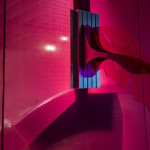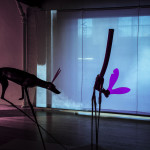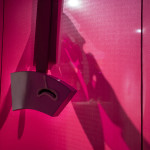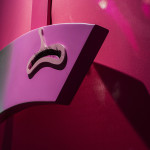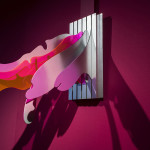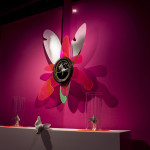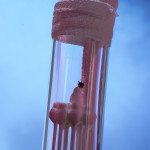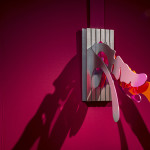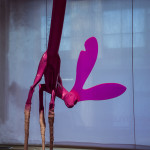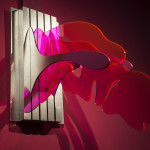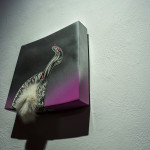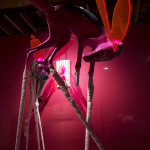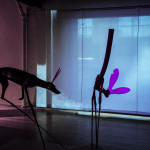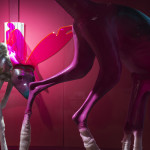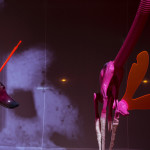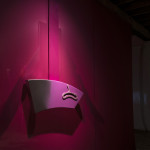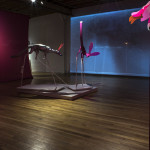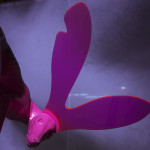GARGOYLES
LUMIR HLADIK AT WALNUT CONTEMPORARY,TORONTO,CANADA / OCTOBER 22 – DECEMBER 8, 2016
curated by Ibérina (Raquel) Vilhena, music by Jacob Soma of PROGRAMM, soprano by Alessandra Paonessa
GARGOYLES
Gargoyles are a celebration of the Kosmos’ unity in complexity, a mockery of ignorance of ignorance as well as a despisement of the human mind’s erring mentation and disorienting languaging.Gargoyles are opening the bizarre, arbitrary universe of human rationality, its ubiquitous platitudes and negation of history and cultural contexts.The Gargoyle installation is a frenzied alchemy of innuendos: mixing biology, history, philosophy and religion.
Mathew Kyba / GARGOYLES… No beginning, no end…
When does an exhibition cease to be aesthetically driven and slip into a larger narrative, becoming an ambiguous symbol for ethical dilemmas? How hard is it to identify this point of no return, the moment when the viewer’s mind slowly drifts from the neon pinks and royal silvers into questions about artificially-enhanced humans and their mating rituals? Lumir Hladik’s Gargoyles exemplifies a type of art show rarely seen; a room that unflinchingly poses difficult questions about humanity’s core values and beliefs, while resisting any easy answer or even possible solution. His tantalizingly coloured works, with sexually charged metaphors and religious symbolism, intertwine together like a ball of mating snakes, no beginning or end. Gargoyles is an “ouroboros”, where each work feeds into the last and continually challenges the viewer to find a sensible reproach.
Standing in the middle of the room are two Coyotes, named Adam K. and Eve S. Propped up on gauzed stilts, their neon ears and investigative snouts pop out from their slender bodies. They appear to be frozen in the middle of a mating ritual; the female has offered her tail/pipe/bottom to the male. But these are “enhanced” coyotes; a pair of animals whose main mating attributes (ears, legs, tails) has all been altered to appear larger, brighter, and sexier. Hladik has always been concerned with the relationship between human and Other, and here is no different. However instead of focusing on their ill treatment, these animals instead act as examples of aesthetically alerted states to attract the opposite sex. Plastic surgery, liposuction, Botox, and even newer forms involving lengthening of legs to increase height all concern the artist. Where is the line drawn?
Sex is an ever-looming theme over the exhibition, if not explicit. As the artist describes the works, he does not shy away from identifying the genitalia that materialize from his abstract forms. Everything is gendered, but ambiguous enough for one to question which is which. A dystopian Altar…? A prominent piece of the installation. Here the conflation of sexual organs and religion is both symbolic and literal. For what reason? It may explain the stone doves often found over tombstones within the exhibition. These doves are the same species and family as the pigeon, but almost always thought to be representative of purity, innocence, and peace. While the pigeon is often cast aside as a nuisance, a carrier of disease. Hladik questions how we can venerate one and dishonor another, essentially the same bird, one is virgin white, untainted by the sullying grey and iridescent breast. The white represents the religious purity, an element only identifiable due to the binary dirtiness that it must define itself against. The video of pigeons fighting conveys the violence inherent in reproduction. Hladik connects the problematic issue of sex with religion to question how these two elements co-exist and operate beside each other. Within cultural and historical contexts, this scene of the “peaceful” creature violently fighting is oxymoronic.
Wall works beckon the viewer inwards to approach their multi-layered drawings. Peering inside the pink exterior, one sees diagrams of muscle tissue. Hladik wants to turn the inside outwards, to investigate how our core concepts and values operate, and to critically assess how complacent traditions have formed our contemporary society. Large pink membranes stretch across the show to preface the abstract works. These act as backgrounds and foregrounds for the show, as everything involves this almost obnoxious pink colour. The hyper sexualization of the art object, the animal, and religious imagery, act as a starting point to start understanding the show. But it ceases there. No final solutions are given. Just as the best endings are those that let the viewer decide what happens, Hladík lets us ponder on how these core values influence each other, and have dominated (outwardly or invisibly) our current societal state.
Stretched thinly across are pink materials, mimicking a skin membrane. These bookmark and contain the inner most scene, doing away with white walls. Surrounded, the viewer experiences everything as if within a body or inner cloister. There is an intimacy here, with the highly dramatic lights that illuminate each work. Yet peering down at us are Hladík’s hyper-abstracted gargoyles. Gargoyles are primarily used to spout water coming down from church roofing, helping stop the eroding process of the mortar walls. Hladik instead removes their utility to instead question what these forms mean. Ambiguity is an important aspect for Gargoyles, and his title works are no different. Are these forms sexual? Threatening? Religious? Once again these queries are invoked but mostly kept open. These neon deities are the culmination of his practice, existing to remain a quandary.
The entire gallery has been transformed into Hladík’s personal chamber, a space where animal veneration and augmentation mesh together to have each viewer come to their own conclusions about the works. The body, both animal and human, are questioned about their co-existence. But overall, there is no single “punchline”, no one-liner that can easily explain Gargoyles. Hladík has defiantly opted to present a deeper, more engrossing experience that requires more time to settle. In a society where everything is faster and more digestible every day, Hladík takes use of the liminal space that the white cube affords. Gargoyles demonstrates that art can and should be difficult, that way the reward for understanding becomes that much sweeter.
Jen Kratochvil / GARGOYLES… everything is arbitrary
Bunch of New York household animals, for life in a city apartment standardized and conditioned pets, embarks on an adventurous journey to save one of their animal friends abducted by vicious, uncivilized street animals…well, at least I think that’s the plot, memory gets quite selective in terms of bad movies. But this one is a special case, particularly short sighted and encouraging stereotypical ways of perception. Animals are, on one hand quite anthropo-manipulated in their behaviour, to be able to reach their true potential (as the trailer propaganda rhetoric would phrase it), but they also keep all their natural pet-kind-of-cuteness. The Cat loves to steal the baked chicken from the fridge in a Tom-and-Jerry-late-1940s-way, lies around lazily and talks to others only when she wants to, well, typical cat, right? Fat dog is always slow and a small idiotic terrier at the end becomes the hero of the story, saves the day heroically to get back to his normal quotidian routine of waiting behind the door for the return of his master, office worker, or Starbucks/ student kind of girl, can’t remember. Everything is oversimplified and dull. Well, it’s a story for kids, right? Why bother with something more elaborate then the usual animated bullshit? Small young female rabbit, coming from a rabbit farm in rabbit town filled with rabbits everywhere, because rabbits come in thousands (that’s how they produce them in rabbit factories), wants to overcome her determined position in the society and become a policemen in the capital of the animal kingdom (sorry, animal democratic republic). Despite all the obstacles, she manages to find the kidnapped animals and group of villains with the Major of town as their boss (who is surprisingly a lion), and becomes a public celebrity. Only to find out that she introduced a spread of hatred from the side of herbivores against carnivores, predators. The situation gets complicated when the whole society gets into disarray with quite intense racism and fear of The Other. The city is saved at the end, obviously, society restructured. Rabbits are still mainly working as farmers on carrot farms, but suddenly no one is surprised anymore if one of them wants to find their own wa of life.
Another story for kids, with relatively well worked out characters, social and political relationships between them, addressing ethnical and hierarchical issues and without any downgrade of level of cuteness and fun. Was it too hard to prepare something wittier for kids then the first example? Hmmm. Stories of animals with human characteristics are old as our culture itself. It’s quite astonishing that their massage is still mostly so banal when it comes to children stories. At least that’s how it works with Hollywood production in cases of above mentioned “The Secret Life of Pets” and “Zootopia” (both 2016).
Everything is arbitrary, we are still trying to see things as they are, but that’s not the Truth.
Pokémon Go is already old news. After the spike of attention earlier this year in June when literally everyone downloaded the app (I did so too), to at least try the experience of proper augmented reality on your phone, the numbers went down rapidly and this autumn no one gives a shit anymore. Even though Forbes has published an article few days ago on the necessity of control in terms of usage of the game in traffic, since the amount of accidents connected with playing the game in a car or on a bike was quite scary. No different from people climbing over fences of private properties to catch a rare specimen of these Japanese creatures. Augmented and virtual realities hit us again after a decade long silence since the beginning of 90s when HMD (head mounted devices) and other gadgets ruled for a short moment the peak of technological development. Now everything is yet to come. Facebook bought Occulus rift approximately a year ago; since then, they are strategizing to find the best way how to introduce this device in connection with social networks in a fundamentally groundbreaking way. Mark Zuckerberg made a presentation earlier this October of first demo how this convergence could look like. After the failure of Google glasses and a span of newly introduced Snapchat goggles, we can expect practically anything (in restrains of what we consider today a social network and augmented and virtual realms itself). So far it’s just fun, we can add an animation of vomiting emoticons or bunny ears to our selfies, which also empowered Apple with their newly restructured iMessages app in iOS10, but soon the possibility of more influential interaction with ourselves, our environment and our friends is imminent. In days to come augmented space and that one we call our reality could merge and those additions to ourselves would be done on our bare bodies and in our brains.
“Gargoyles are tubes. Everything life is tubular. The tube is the cornerstone of everything organic, everything life. The Gargoyle installation appropriates quite a variation of tubular concepts and mixes them into a frenzied alchemy of history, religion, philosophy and biology. Everything tube includes arteries, ears, grass helms, cross sections of intestines, esophagi, and ultimately uteri, penises, fallopian tubes and vaginas. Vagina is the gate to Kosmos, a valley with the most mysterious cave. Once dead, a dead female body is of no interest. The ultimate StarGate becomes sterile anatomy.”
Lumír Hladík
“First we have to kill the wild beasts…”, Julius Verne, Mysterious Island
Coyotes… these animals are dead, they are skinned, not alive, they were never alive, they are just manikins for taxidermy purposes. But they have a life of their own, they have their consciousness, imaginary one and through it, they are augmenting themselves, enriching their stripped down matrix, their forms and their meaning. Prolonging limbs, enlarging their body parts, gracing themselves. Augmenting the core of the perception, no matter from where such perception originates, either from them or their environment. Who are they and why are they here is not important. They have their indisputable presence. Every era has its standardized vision of beauty; this is at play here and now, in these animals, through their own reality, as a representative example of behaviour and aesthetic standards of their species.
“Pink paint, well… that’s the innocence of a young girl’s room, that’s sex, that’s death or an urge to fight against it with all the pink ribbons in the air symbolizing such a fight.”
L.H.
Anthropocene, designated era when human activities started to actively shift given conditions of the Earth and it’s ecosystems, is one of the most prominent subjects of current art production. It makes one wonder how would we perceive it in maybe 10 years. Our ability to believe in state of the art of our present is giving so many times a space for a mistake, due to blind trust to certain un-provable premises. One story from a time of dominance of “system theory” in ecology in the 70s caught my attention. Ecologist George van Dyne, being absolutely sure that nature functions as a stable structure, used certain area of Colorado’s grass lands to conduct an experiment. His team gathered all possible kinds of data from that specific location and started to fill IBM memory cards and super computers of that period with gargantuan amounts of data. Data about every piece of grass, about every insect they were able to collect, about every animal, from small field mammals to bisons living there (he even cut open a hole into a stomach of one of those to have a precise idea about what is the creature consuming). His goal was to create a digital model of nature and possibly use it as a model to follow for the society of that time. How terrifying for him must have been the revelation that altogether nothing made any systematic sense. That nature doesn’t have a balanced system but works on a model of constant adaptation and improvisation. Another vision ruined. Van Dyne died from a hearth attack, either from a total fatigue, disappointment and disillusion or for whatever other reason. And he wasn’t able to predict his own dead either.
The prevalent concern of our human kind is an urge to escape mortality, to fuck and to kill”
L.H.
Legal status of animals are going through a major shift during last five years, both public and political debates about their rights and the question of their place next to men as sentient beings is making quite a turmoil. If my dog will be pronounced sentient, what about the original source of the beef I’m feeding him and myself with? Certain countries already made their huge step forward, implementing new legislation in regards to animals. But we can’t talk to them and ask them, right? Thus again deciding something for someone without their understanding and ability to counteract in the discussion, the voice their own concerns. So is this just a play of privileged interest groups to give their fancy pets new status in a same way as they are getting new Winter outfits or is this a initiation of new path men could take to stop considering himself a sole ruler of this Earth?
Arbitrariness is Everything.
This year’s Berlin Biennial, curated by a New York based DIS Magazine, was a big thing. The Guardian claimed that those guys are idiots, neglecting the grave state of our current society, missing on ultra-important political issues we all have to deal with. Their vision and vision of all those artists exhibiting there were so much up to the point of present human condition struggling with our newly conceived digital worlds that there could be no more stronger statement about what we are and where are we heading (especially since we have no idea where we are heading). Manifesta in Zurich curated by German artist Christian Jankowski, who’s work was formative for the western art discourse during the 90s also received critical comments pointing out that few Lego bricks put together are more political then his exhibition. Even though Jankowski, again, presented art touching the grounds of pressing questions about the conditions of human labour nowadays; questioning how we work, how we rest, how we deal with our time, how we deal with each other.
Current art discourse developed a world-view emphasizing a very fragmentary idea of what it means to be political. Lumír Hladík’s exhibit could be also considered superficial, taking on subjective ways of thinking and perception of this Czech-Canadian artist. Hladík is presenting his stand points and his concerns, his fears and observations, but who is there to say that they are less pressing then the power games about supposedly true politics and problems of our world. The questions of symbolic meanings and their manipulative backgrounds, questions concerning the position of men in relation to the rest of creation on this Earth, literally questions of life and death in very singular viewpoint, all those could be enlarged in understanding of its viewers into omnipresent issues we all have to deal with. Hladík is playing with shifts of meanings, constructing his mosaic of what we are. Let’s be perceptive enough to play along his game.
And what about the dragonflies?




